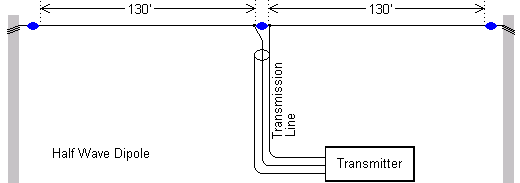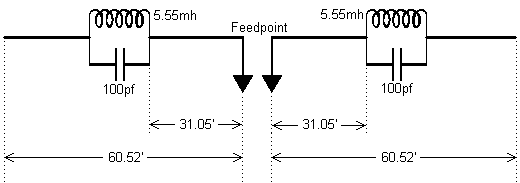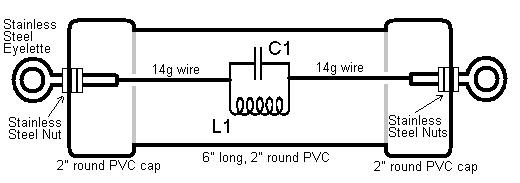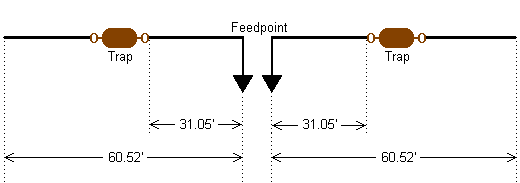Author: Frederick R. Vobbe, W8HDU
January 31, 2008
| Antenna 006: Switched/Trapped Dipole Author: Frederick R. Vobbe, W8HDU January 31, 2008 |
| A multiple band dipole can be made very easy to build. This antenna allows you to operate on several bands. There are two flavors of this style antenna, the switched dipole, and the trapped dipole. A switched dipole required you to physically go out to the antenna and jumper segments of the antenna into place. The trapped dipole is an electronically switched antenna.
The antenna should be as long as your lowest frequency. Here is what a regular half wave dipole antenna on 80 meters looks like.  So if we cut the wire in the center of each leg, add an insulator, and then make a small jumper with an alligator clip, you can now use the antenna on two bands!  However, who wants to have to stop for a moment to run outside to change the jumpers on the antenna when you change band operations? The solution is to electronically add the switch/jumper with what is called a "trap". In the diagram below, you'll note an L/C circuit inserted in the middle of each leg of the antenna. This circuit "traps" any signal from utilizing the whole length of the wire. So one signal takes the entire 130 foot length of the wire, and other signal (band) takes only 65 feet of wire.  How do you build the balun. It's pretty easy, and fairly cheap. You need a coil (L1), a capacitor (C1), a piece of PVC tube, a small length of 14g solid wire, (2) end caps, (2) Stainless Steel eyelette, and (6) Stainless Steel nuts.  A better representation of how the antenna looks with the traps in the wire.  One the trap antenna is installed, now you don't have to run outside and change the jumpers! So how do you tune the antenna? When installing the antenna, always tune, (lengthen or shorten the wire length), the smallest section first. Then tune the next longest section. Notice I didn't say last section, as you can easily design an antenna with multiple traps in the wire. For example, a 10, 15, 20, and 40 meter trapped dipole. As you have read in my other articles, you can also use dipoles in guying situations. And a trapped dipole would work well. However, the trap should always be placed across a porcelain insulator. Never use a trap that you have built from PVC in a guy wire as you can pull the trap apart. And having a guy wire break also is not good for the structural integrity of the tower! |
 |
© Copyright 2012 All Rights Reserved - W8HDU |